Keywords
|
| Ceiling Fan, Daubechies, Harmonics, Passive filters, Personal Computer, Power quality, Three phase induction motor, Wavelet transform. |
INTRODUCTION
|
| Due to the ever increasing number of nonlinear loads on distribution systems, the existence of harmonics is inevitable [2]. Examples of common sources of power system harmonics include entertainment devices such as television, VCR’s and audio amplifiers, information technology devices like personal computers, printers and fax machines, variable speed motor drives for HVAC, food preparation and cooking products such as microwave ovens and cooktops, and lighting products that include electronic ballasts, compact screw-in fluorescent lamps (CFLs), and other power conversion devices that operate a variety of lamps. |
| These non-linear loads create harmonics by drawing current in abrupt short pulses, rather than in a smooth sinusoidal manner and damage the components of the networks in user’s equipment. High levels of harmonic distortion can cause several effects such as increased transformer, capacitor, motor or generator heating, false operation of electronic equipment (which relies on voltage zero crossing detection or is sensitive to wave shape), incorrect readings on meters, false operation of protective relays and interference with telephone circuits. As a consequence there occurs power quality loss due to non-sinusoidal voltage and current waveforms [3]. This necessitates the study of the combined effect of unbalance and nonlinearity on power system voltages and currents. |
| This paper considered some of the major harmonic producing loads like three phase induction motor, personal computer and ceiling fan. Power quality analyser (PQA-PW3198) was used to facilitate the experimental analysis of the above power quality problem. Passive filters and wavelet transforms were applied to reduce the total harmonic distortion. Advantage of using wavelet transform is that, it can detect and classify different power quality problems. |
| A. Harmonic elimination using passive filters: |
| There are two categories of solutions available for mitigation of harmonics either reduce the harmonics at their point of origin (before they enter the system) or apply filtering to reduce undesirable harmonics [4]. Many methods for reducing harmonics at their origin are available. In most cases, however, reducing or eliminating harmonics at their origin is effective only in the design or expansion stage of a new facility. For existing facilities, harmonic filters often provide the least-cost solution. |
| Harmonic filters can be subdivided into two types: active filters and passive filters. Active filters are commercially feasible products only for high-power applications, where power factor correction capacitors already exist. It is typically more cost effective to use passive filtering. Typical passive filter inserted on the supply side of three phase induction motor is shown in Fig.1. |
| B. Wavelet-based Harmonic Elimination: |
| Wavelet analysis is a powerful signal-processing method that is particularly useful for the analysis of non-stationary signals [5], [6],[7]. Wavelets are short-duration oscillating waveforms with zero mean and fast decay to zero amplitude at both ends which are dilated and shifted to vary their time-frequency resolution. The wavelet coefficients work as weights of the wavelets to represent the signal at these locations and scales. Wavelet transform can be performed on continuous and discrete functions respectively referred to as the continuous wavelet transform (CWT) and discrete wavelet transforms (DWT). |
| Wavelet decomposition theory is used to concentrate the signal energy to a small number of large coefficients. The coefficients which fall into a rejection band are dropped and those that are not located within the band are reserved or shrunk. The signal is usually decomposed into a few large coefficients whereas the distorted signal gives rise to small coefficients only. This property ofthe wavelet transformation helps to suppress the harmonics part of the signal. |
| The general wavelet-based harmonic elimination method proceeds in three steps: decomposing the distorted signal, thresholding the wavelet coefficients, and reconstructing the signal as shown in Fig.2. In the first step, the signal is transformed into the wavelet domain and represented by its coefficients at different scales. This stage requires that three elements be chosen. They are namely, the type of mother wavelet, the order of the mother wavelet, and the level of the decompositions [8],[9]. Once these parameters are set, the wavelet decomposition can be performed. Wavelet harmonic elimination methods can be carried out using either hard or soft thresholding. |
EXPERIMENTAL ANALYSIS
|
| A. Three Phase Induction Motor: |
| The three-phase induction motor also called an asynchronous motor is the most commonly used type of motor in industrial applications. Some of the advantages of induction motors are simple design, low cost, reliable operation, easy replacement, variety of mounting style and different environmental enclosures. Most of the induction motor’s performance is affected due to poor quality of power which can be identified as voltage imbalance, voltage fluctuations, notching, noise, sag, low frequency transients, interruptions, harmonic distortions, etc.[10]. Voltage harmonic frequencies produce additional heat in the motor that increase eddy current and hysteresis losses. |
| The most commonly used harmonic index to determine the extent of distortion of current is the Total harmonic distortion (THD), it is defined as the ratio of the sum of the powers of all harmonic components to the power of the fundamental, as given in Equation 1. |
 |
| Data collection and analysis was performed on three phase induction motor with passive filter using PQAas shown in Fig.3. |
| B. Personal Computer: |
| Computer loads and systems are being increasingly used in all industrial, commercial and residential sectors. The nature of these loads is such that, they not only draw distorted current from the source, but can significantly distort the supply voltage waveform causing disruption in system performance. The switched mode power supply (SMPS) used in computer loads draw highly distorted current from the source. Significant amount of odd harmonics including triplens are present. |
| Experimental set up for analysis ofharmonics generated by personal computeris as shown in Fig. 4. PQA is used to analyse harmonics and it is eliminated using wavelet transforms. |
| C. Ceiling Fan: |
| The ceiling fan is indispensable electrical equipment to any Indian household for providing relief from the warm, tropical climate. Almost every urban electrified household has a minimum of 2 to 3 ceiling fans. The Indian Fans Manufacturers Association estimated the size of the fan market in 2007 at 30 million fans with an annual growth rate of 10%. The power output from normal fan motor is not a regular sinusoidal waveform and consists of high frequency harmonics. The THD of such equipments will exceed the normally acceptable limits of 5 to 6%. Such a non-sinusoidal waveform directly runs the magnets in the motor, causing it to spin. The harmonics effectively reverse the polarity of the magnets, which causes the humming of motors and reduces its life. |
| Experimental set up for analysis of harmonics generated by ceiling fan is as shown in Fig. 4. PQA is used to analyse harmonics and it is eliminated using wavelet transforms.A. Three Phase Induction Motor under No Load Condition: |
| The experimental analysis was carried out for three phase induction motor under no load condition using PQA. The distorted current waveform obtained is as shown in Fig. 5. The harmonic analysis data are as tabulated in Table 1. |
| From Table 1, it was observed that the 5th order harmonic current component was predominant with a value of 9.79% and current THD of 10.18%. Since 5th order harmonic is predominant in this problem, the passive filter is designed for the elimination of this harmonic component and results are compared with wavelet transform method. |
| The filtered current waveform using passive filter for three phase induction motor under no load condition is as shown in Fig.6. |
| In order to eliminate the harmonics from the distorted signal using wavelet transform, the signal was tested with all the mother wavelets. Amongst all, “Daubechies 19” mother wavelet has been found to be suitable for this application. The signal was decomposed up to various levels and by trial and error decomposition level was selected. The decomposition level 10 has given appreciable result. The filtered signal was decided by choosing only the approximate component at level 6 (a6), because it exhibits better reduction of THD. Fig.7 shows the approximate coefficient waveforms for db19 applied to distorted signal shown in Fig.5.The filtered signal by this method is shown in Fig.8. |
| Harmonic analysis carried out for three phase induction motor under no load condition using PQA with passive filter and wavelet method is tabulated as in Table 2. |
| Using passive filters, the 5th order harmonic distortion was reduced to 8.0% whereas wavelet method provided reduction of about 0.98%, with an improved performance of 87.75% compared to passive filter. The current distortion was reduced to 8.98% using passive filters and 4.78% using wavelet transform, with an improved performance of 46.6%. Percentage Reduction of peak amplitude obtained was 3.0% with wavelet transform and 1.25% with passive filters. From the results it is observed that, the wavelet transform is best suited for this application. |
| B. Three Phase Induction Motor under Full Load Condition: |
| The experimental analysis carried out for three phase induction motor under full load condition using PQA provided distorted current waveform as shown in Fig.9. The harmonic analysis data are as tabulated in Table 3. |
| From Table 3, it was observed that the 5th order harmonic current component was predominant with a value of 5.77% and current THD of 6.1%. Since 5th order harmonic is predominant in this problem, the passive filter is designed for the elimination of harmonic component and results are compared with wavelet transform method. |
| The current waveform with passive filter for three phase induction motor under no load condition is as shown in Fig.10. |
| Application of the wavelet method with Daubechies (db19) as mother wavelet for the distorted signal shown in Fig. 9 provided the filtered signal as shown in Fig.11.The filtered signal was decided by choosing only the approximate component at level 6 (a6), because it exhibits better reduction of THD. |
| Harmonic analysis carried out for three phase induction motor for full load condition using PQA with passive filter and wavelet transform method is tabulated as in Table 4. |
| The distorted current waveform of THD 6.1% was reduced to 5.39% using passive filters and 4.96% using wavelet transform, with animproved performance of 7.98%. By using passive filters, the 5th order harmonic distortion was reduced to 5.18% while the wavelet method provided 1.55%, with an improvement in the performance of 70.07%. Percentage reduction of peak amplitude obtained was 8.9% with wavelet transform method and 5.4% with passive filters. From the results it is observed that, the wavelet transform is best suited for this application. |
| It is observed from the results obtained with both three phase induction motor under no load and full load conditionthat, the wavelet transform provided better results. Hence, for the elimination of harmonics in nonlinear loads like personal computer and ceiling fan, only wavelet method is applied. |
| C. Personal Computer during turn on: |
| The experimental analysis carried out for a personalcomputer during turn on, using PQA provided the distorted current waveform as shown in Fig.12. Application of the wavelet method with Daubechies (db19) as mother wavelet for the distorted signal shown in Fig. 12 provided the filtered signal as shown in Fig.13. The filtered signal was decided by choosing only the approximate component at level 6 (a6), because it exhibits better reduction of THD. |
| Comparison of harmonic details between original data from PQA and wavelet method is tabulated as in Table 5, during turn on of computer. The current harmonic distortion of 23.7% was reduced to 4.74% at level a6. The 5th harmonic component that was predominant at 13.38% was reduced to 0.45%. The percentage amplitude reduction of the filtered signal was14.67%. |
| D. Ceiling Fan: |
| The experimental analysis carried out for aceiling fan provided the distorted signal obtained from PQA as shown in Fig.14. |
| Application of the wavelet method with Daubechies (db19) as mother wavelet for the distorted signal shown in Fig. 14 provided the filtered signal as shown in Fig.15. The filtered signal was decided by choosing only the approximate component at level 6 (a6), because it exhibits better reduction of THD. |
| The comparison of harmonic details between original data from PQA and waveletmethod is tabulated in Table 6 for a ceiling fan. For position 1, the current harmonic distortion of 5.91% was reduced to 4.89% with wavelet method. For position 4, the current harmonic distortion of 3.24% was reduced to 2.822% with wavelet method. The 5th harmonic component that was predominant at 3.0% was reduced to 0.1285% at position 4. The percentage amplitude reduction of the filtered signal was1.1%. |
CONCLUSION
|
| The voltage and current waveforms were analysed using PQA for three phase induction motor, personal computer and ceiling fan under different load conditions. It is observed that significant distortion in the current exists due to the use of such non-linear loads. In the three phase induction motor, the 5th order harmonics was found to be predominant, hence passive filter was designed accordingly. Wavelet analysis was performed using Daubechies 19 as the mother wavelet and successfully got a filtered pure sinusoidal waveform with reduced 5th order harmonic providing better results than that of passive filters. Further, the wavelet method is implemented for the other loads like personal computer and ceiling fan to obtain reduction in current harmonic distortion.With availability of various harmonic mitigation techniques, research is being carried out for the best reduction of THD. |
ACKNOWLEDGEMENT
|
| The authors are indebted to Visveswaraya Technological University, Belgaum for funding the project. We are also thankful for BNM Institute of Technology and its R&D centre in Electrical & Electronics Department for providing lab facility in conducting and analysing with PQA for proposed analysis and mitigation of harmonics in non-linear loads using passive filters and wavelet transforms. |
Tables at a glance
|
 |
 |
 |
| Table 1 |
Table 2 |
Table 3 |
 |
 |
 |
| Table 4 |
Table 5 |
Table 6 |
|
| |
Figures at a glance
|
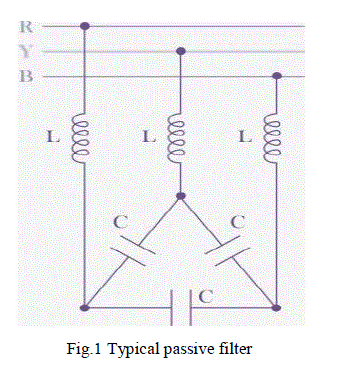 |
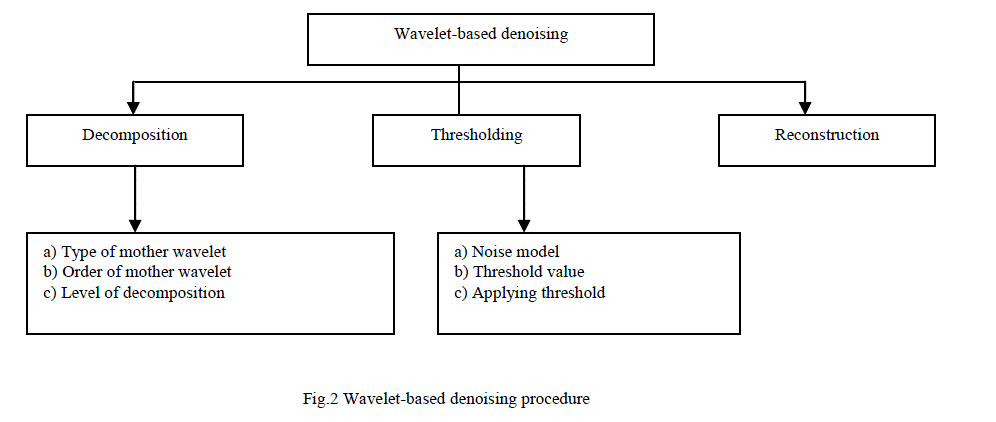 |
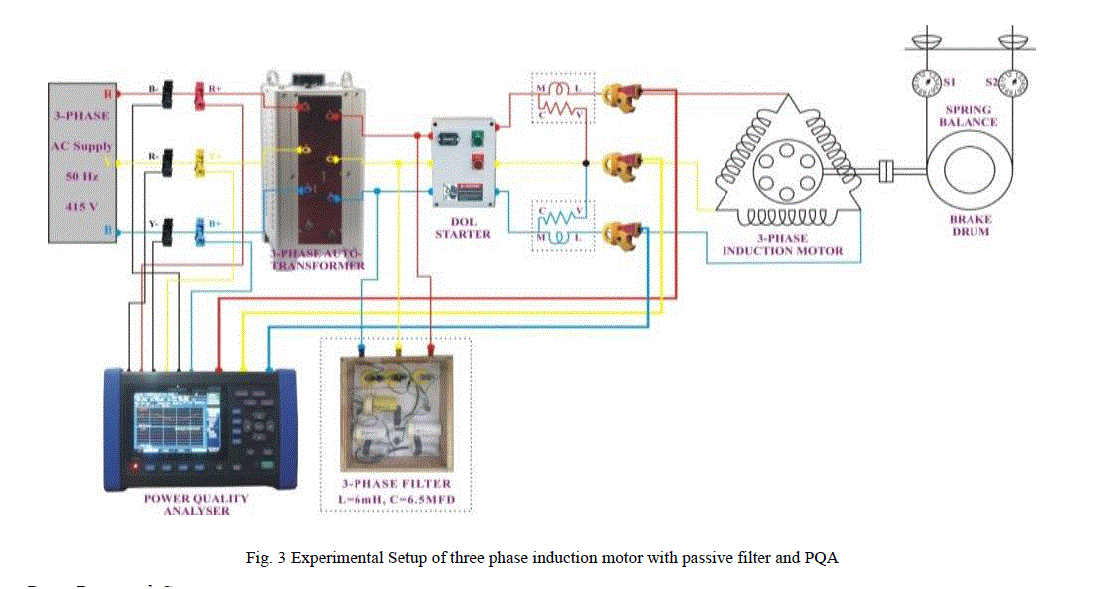 |
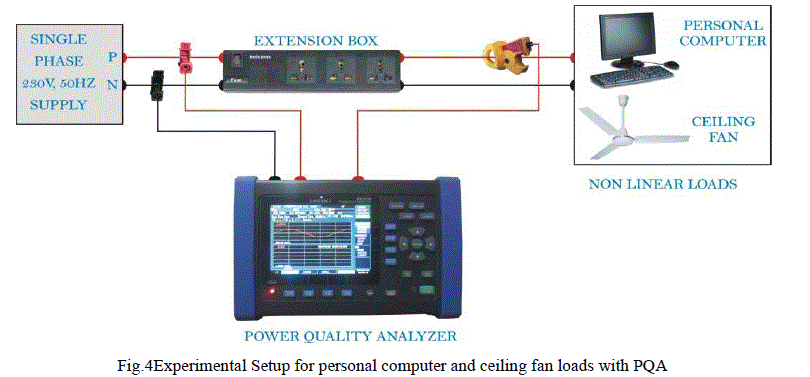 |
 |
| Figure 1 |
Figure 2 |
Figure 3 |
Figure 4 |
Figure 5 |
 |
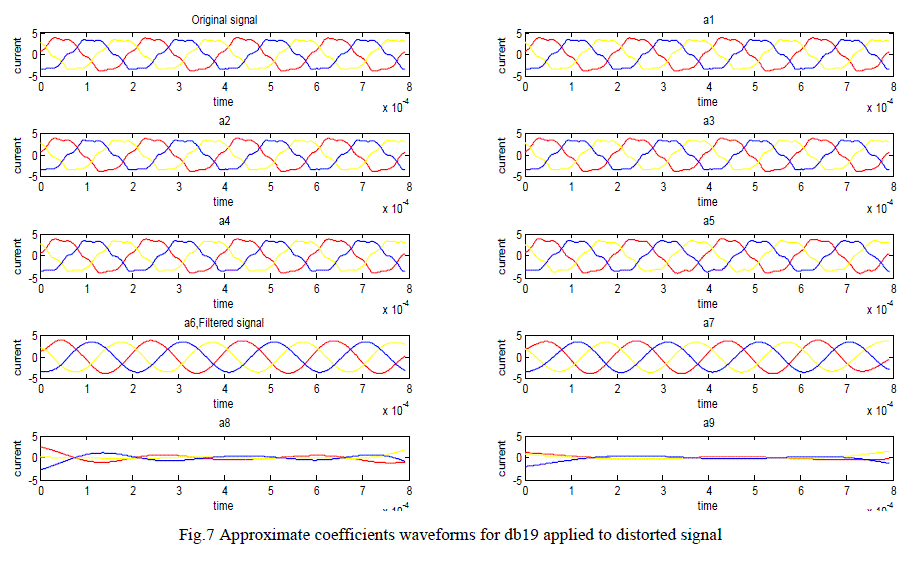 |
 |
 |
 |
| Figure 6 |
Figure 7 |
Figure 8 |
Figure 9 |
Figure 10 |
 |
 |
 |
 |
 |
| Figure 11 |
Figure 12 |
Figure 13 |
Figure 14 |
Figure 15 |
|
| |
References
|
- Dr. Kurt Schipman, Dr. François Delince, “The importance of good power quality” ABB Power Quality Products, Belgium.
- M.I.AbuBakar, “Assessments for the impact of harmonic current distortion of non-linear load in power system harmonics”, Transmission and Distribution Conference and Exposition: Latin America, 2008 IEEE/PES, 2008.
- A.Priyadharshini, N.Devarajan, AR.Umasaranya, R.Anitt, “Survey of harmonics in non-linear loads” (IJRTE) ISSN: 2277-3878,
- Volume-1, Issue-1, April 2012. [4]. J.L.Hernandez , MA. Castro, J. Carpio and A. Colmenar, “Harmonics in power systems” in International Conference on Renewable Energies and Power Quality, (ICREPQ’09), Valencia, Spain, 15th to 17th Apr 2009.
- Angelo Baggini, “Wavelet network based detection and classification of transients Handbook of Power Quality”, University of Bergamo, Italy14PSCC, SEVILLA, 24-28 JUNE 2002.
- T.Lachman, A.P.Memon, T.R.Mohamad, Z.A.Memon, “Detection of power quality disturbances using wavelet transform technique”, International journal for the advancement of science & arts, vol. 1, no. 1, 2010.
- Angrisani L, Dipt. Di Ing. Dell: Inf. Ed Ing. Elettrica, Salerno Unio, “A measurement method based on the wavelet transform for power quality analysis”-IEEE Transactions on Power Delivery, Vol. 13, No. 4, October 1998.
- Vidya H A and V Krishnan, “Some investigations on denoising of partial discharge signal using wavelet transform”, Ph.D Thesis, VTU, Belgaum,2009.
- Gaouda A.M, Salama M.M.A, Chikhani A.Y, Sultan M.R, “Power quality detection and classification using wavelet-multiresolution signal decomposition”, IEEE Transactions on Power Delivery, Vol. 14, No. 4, October 1999.
- DavarMirabbasi, GhodratollahSeifossadat ,MehrdadHeidari, “Effect of unbalanced voltage on operation of induction motors and its detection”, Electrical and Electronics Engineering, 2009, ELECO 2009 International Conference.
|